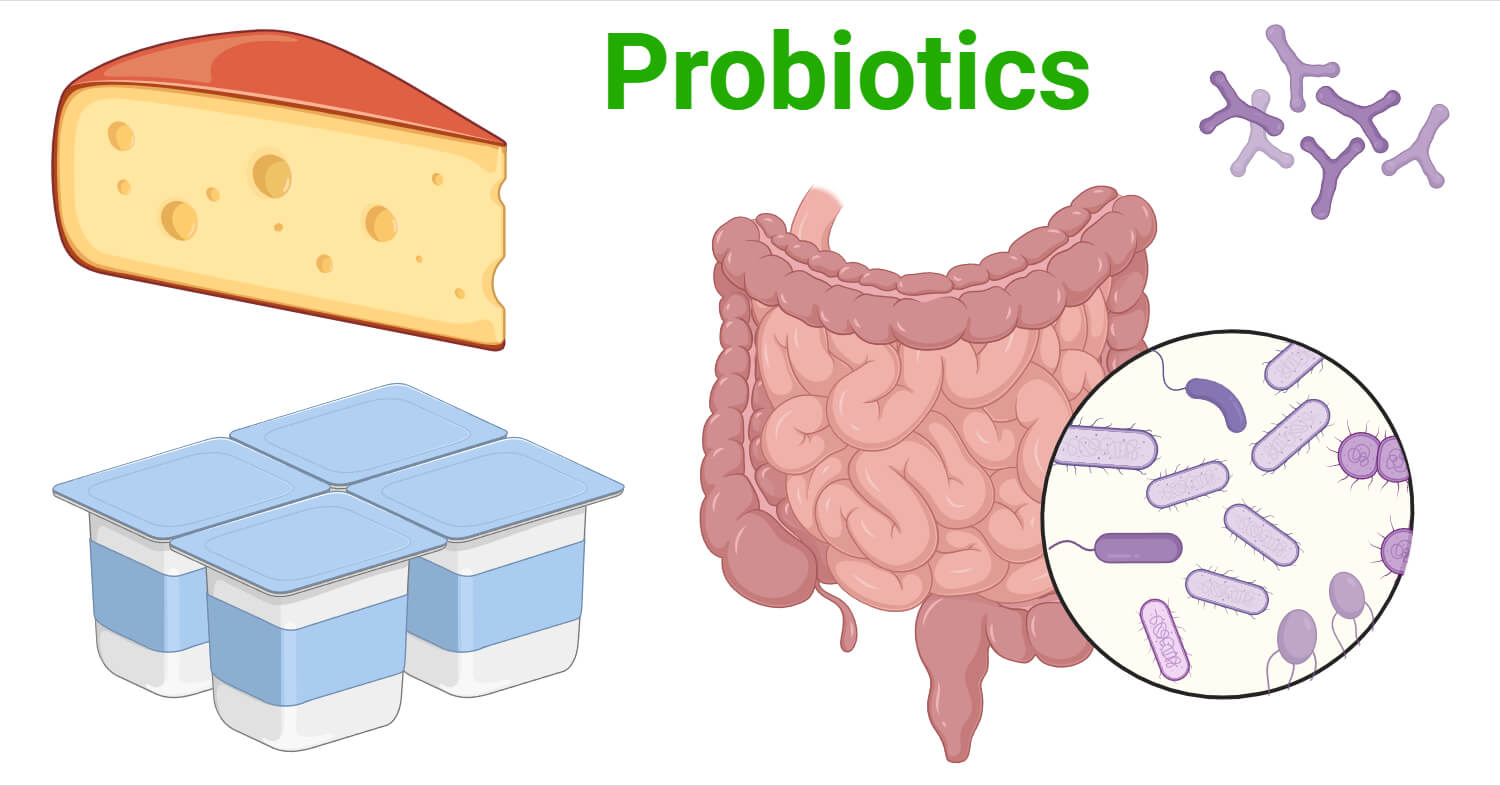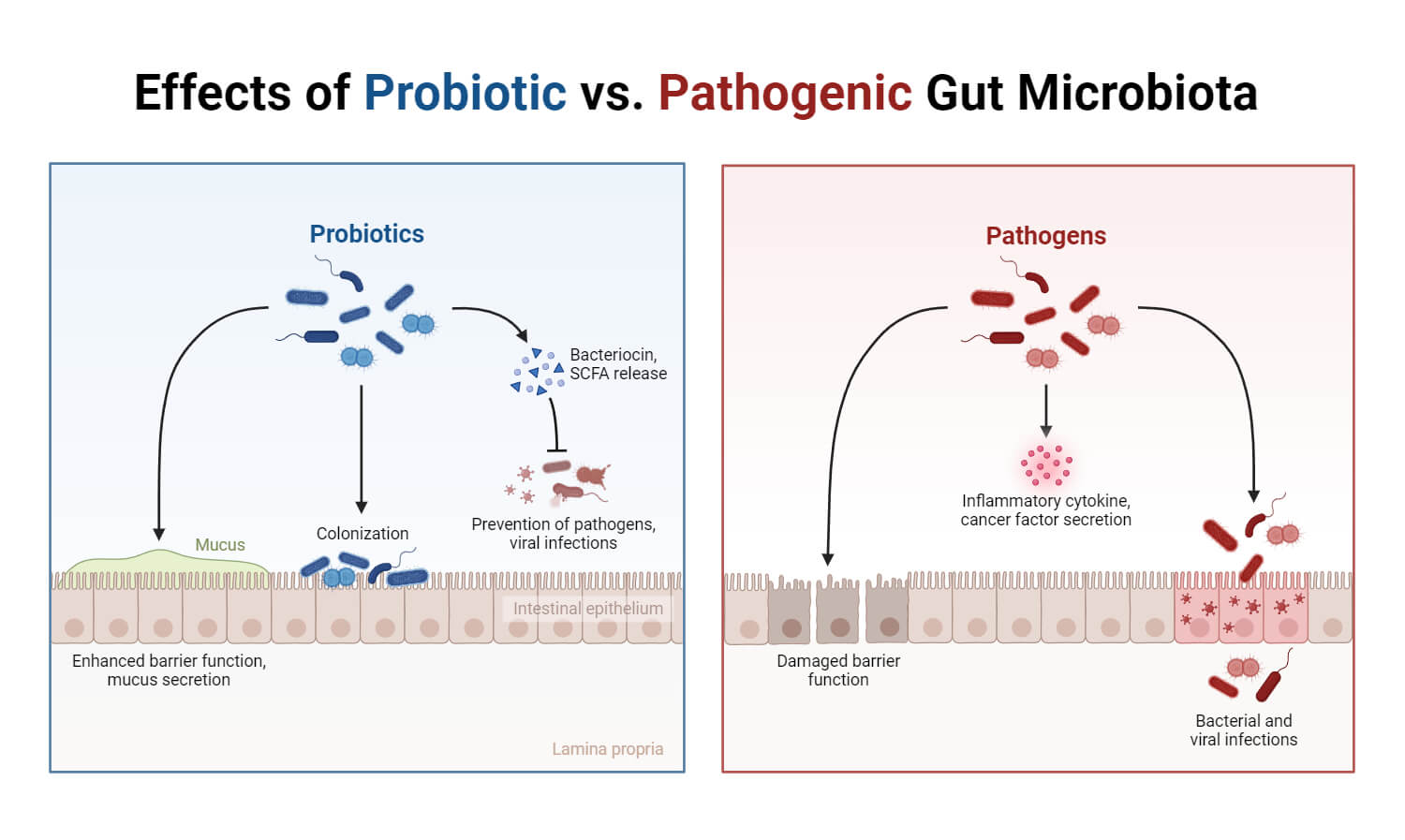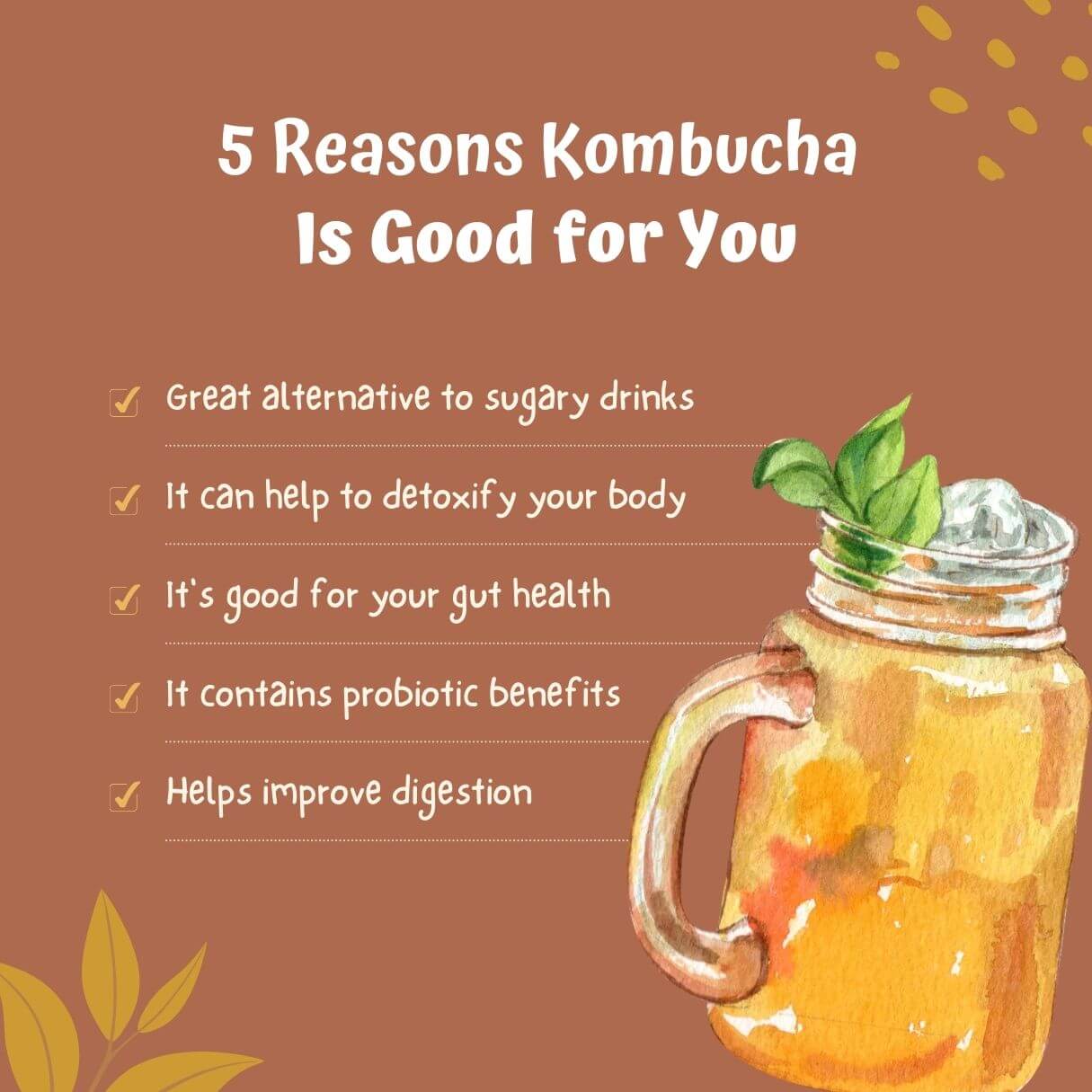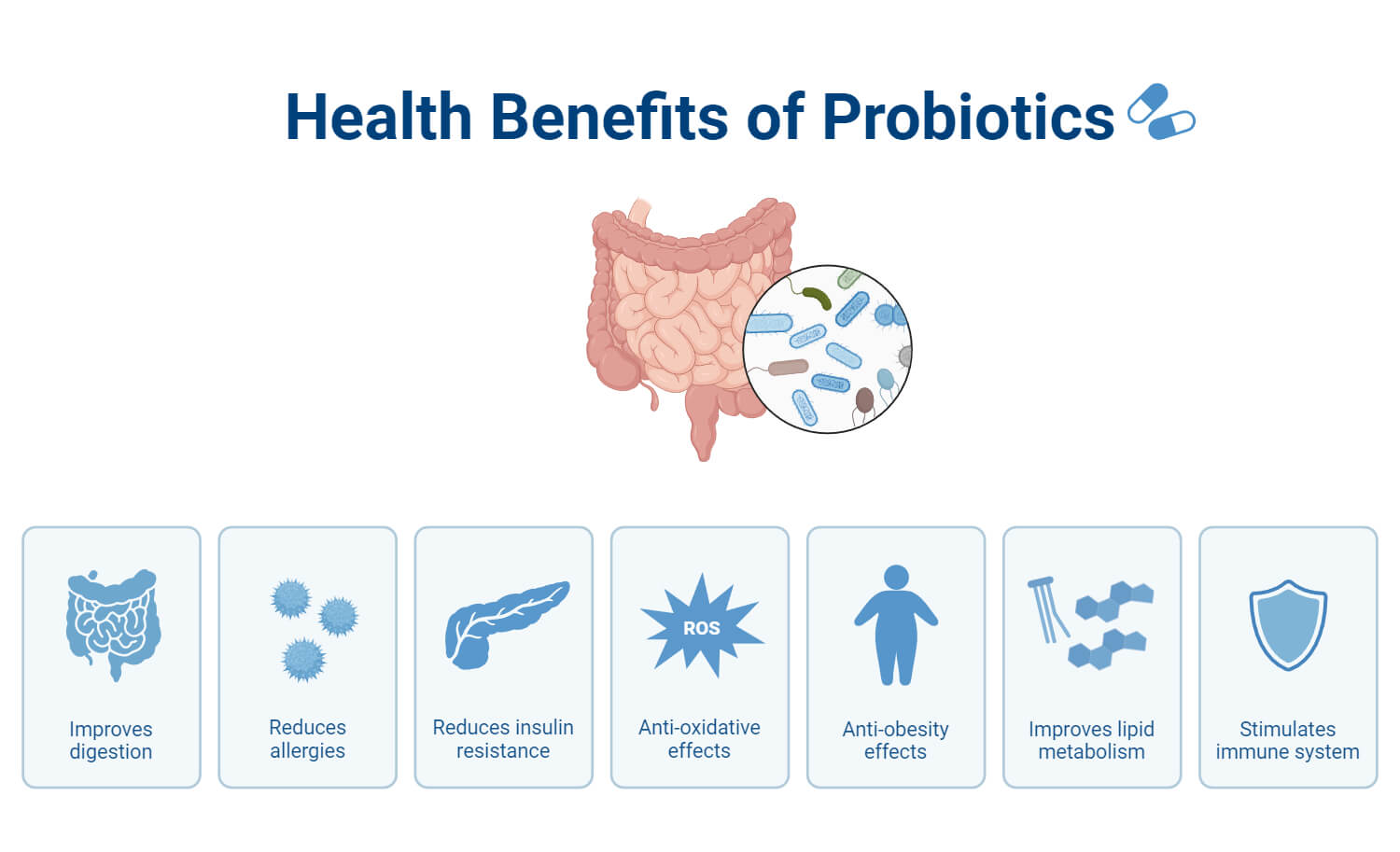Probiotics are live microorganisms (bacteria and yeasts) present in foods, such as yogurt and sauerkraut, and supplements, which are innocuous (not harmful) to our human health and host.
- It helps to improve the normal microflora present in the body. It is also available as a dietary supplement, such as a capsule or powder.
- Researchers have been researching probiotics and the relationship between normal microflora and disease. They have been researching novel and advanced probiotics with better benefits.
- Although probiotics are recommended in a healthy diet, they might lead to side effects, but it’s rare. Additionally, probiotics are used as a form of medicine.

- Many organisms stay in the human body, such as the gastrointestinal tract, nose, and genitals, and have fruitful bodily properties and functions. Similarly, beneficial microorganisms like probiotics live in the body, which helps to control and enhance immunity against infectious pathogens, germs, or dirt particles.
- Although microorganisms are already present in the human body, there are also different ways to have probiotic products inside your body, like ingesting oral supplements that pass into our gastrointestinal tract and another one is applying topical products on your skin surface or to the mucous membrane inside your body cavities such as nose or genitals.
Interesting Science Videos
History of Probiotics
The term probiotic was obtained from the Greek word that means “for life.”
- First, Lilly and Stillwell used the term probiotics in 1965, where he described an organism that secretes a substance that helps to stimulate the growth of another.
- The definition of probiotics changes with time and the development of knowledge.
- In 2001, Schrezenmeir and De Vrese described probiotics as “a preparation of or a product containing viable, defined microorganisms in sufficient numbers, which alter the microflora by implantation or colonization, in a compartment of the host and by that, exert beneficial effects on host health.”
- In 2002, Food and Agriculture Organization (FAO) and World Health Organization (WHO) experts described probiotics as “live microorganisms, which when administered in adequate amount confer a health benefit on the host.” It means if taken in proper amounts, it will provide health benefits to the host.
- In 2009, the World Gastroenterology Organisation (WGO) defined probiotics as living organisms that benefit consumer health when ingested in adequate concentration.
Properties of Probiotics
- In probiotics preparation, they should be generally recognized as safe (GRAS).
- It should possess a desirable antibiotic susceptibility testing- antibiogram profile.
- They should be non-pathogenic, non-allergic, non-mutagenic, and not promote inflammation in individuals.
- They should have resistance properties against bile, hydrochloric acid, and pancreatic juice.
- They exhibit anti-carcinogenic activity.
- They should have the strength to boost the immune system and decrease intestinal permeability.
- They should be able to produce lactic acid.
- They should survive in both acidic conditions of the stomach and alkaline conditions of the duodenum.
- They should possess genetic stability and have no mechanism for transferring plasmids.
- Strains must be capable of rapid multiplication with good viability and stability in the product during storage.
- Probiotic foods must contain enough live probiotic cells to deliver health benefits to consumers, which provide better quality.
- Probiotic strains must have good sensory properties.
- They should originate from human origin.
- They should possess metabolic activity.
- For the bacteria to thrive in the colon, they must be able to attach themselves to and colonize the lining of the epithelial cells.

Sources of Probiotics
The sources of probiotics are fermented food, unfermented food, and dietary supplements. Some of the sources are:
- Sourdough bread
- Yogurt
- Tempeh, Natto, Kefir
- Commercial pickles
- Pickled onions, Pickled beets, Pickled cucumbers (if fermented but not canned)
- Cultured buttermilk
- Fermented fish (utonga-kupsu)
- Apple cider vinegar
- Kimchi (a Korean fermented cabbage dish)
- Cheese and deli meats
- Kombucha (a fermented tea)
- Sauerkraut (fermented cabbage)
- Miso (a fermented soybean-based paste)
- Unfermented foods (milk, juices, smoothies, cereals, nutrition bars, and infant and toddler formulas)
- Dietary supplements ((in capsules, powders, liquids)

Fermented Food
- Fermented food, obtained by the growth and metabolic activity of the cultural strains, contains live microorganisms.
- Fermented foods (such as yogurt, pickles, and so on) that contain organisms have health benefits. These organisms can survive for the entire duration of their shelf life in the product.
- The most common probiotics are Lactic acid bacteria (LAB) and Bifidobacterium.
Unfermented Foods
- Unfermented foods such as juices, nutrition bars, and so on also contain microorganisms, which can also be considered probiotics.
Dietary supplements
- Dietary supplements such as capsules, powders, and so on contain a variety of mixed stains. It is taken as a medicine also.
- One of the probiotic medicines is bifilac.
- This medicine helps boost the immunity of the digestive tract, which enhances the ability to absorb nutrients from digested food.
- It also controls diarrhea and helps to balance the gut microflora, such as bacteria and yeast.
- The ingredients used in the Bifilac capsule are from mixed cultures such as Lactobacillus sporogenes, Streptococcus faecalis, Clostridium butyricum, and Bacillus mesentericus.
- You can find this product in the market in such a way as: Bifilac Capsule, Bifilac HP Capsule, Bifilac Dry Syrup – for Children, Bifilac Lozenges, and Bifilac Sachet.
- Probiotics can be measured in colony-forming units (CFU), indicating the number of viable cells.
What do probiotics do?
- Probiotics are food products that are present within our gut. It improves the properties of microflora and balances the gastrointestinal microbiome.
- It strengthens the body’s natural defense mechanisms, promoting the growth of beneficial microorganisms and suppressing harmful bacteria.
- Probiotic gets attached to the intestinal mucosa. Metabolic by-products like acid, hydrogen peroxide, and bacteriocins such as lactocidin and acidophilin are the products that exhibit antibiotic properties and hinder the growth of a broad range of pathogens.
- Probiotics produce essential metabolites- beneficial by-products- that help us in a proper digestion process.
- Lactic acid bacteria hinder the growth of pathogenic microorganisms.
- It produces short-chain fatty acids such as acetic, propionic, butyric, lactic, and formic acids and reduces intestinal pH. It exhibits antimicrobial activity against yeasts, molds, and bacteria.
- During fermentation in the colon by the microflora, the short-chain fatty acid production helps prevent colorectal cancer.
- Probiotic helps to treat dysbiosis. Dysbiosis is the imbalance of the microbiome present in the gastrointestinal tract and gut that causes changes in functional and metabolic properties- leading to problems such as chronic diseases like IBD, IBS, diabetes, cancer, gut, vagina itching, skin, oral areas- bad breath, upset stomach, and diarrhea.
- Each microbe has a different role within the body. It might bear side effects for some people, but it’s a relatively rare occurrence.
- Besides, it also helps to balance good and bad microflora that keep your body healthy and properly functioning.
Types of Probiotics and Microorganisms
Many microorganisms are involved in probiotics that show no harmful effect on human health, such as Lactobacillus (The first and largest group of microorganisms), Bifidobacterium, Saccharomyces, Streptococcus, Enterococcus, Escherichia, and Bacillus.

The most common are:
- Lactic acid bacteria such as Lactobacillus, Streptococcus thermophilus, and so on
- Bifidobacterium sps.
- Sachharomyces boulardii
a. Lactic acid bacteria
- Lactic acid bacteria, carbohydrate fermenters, are gram-positive, aerotolerant, non-spore-forming lactic acid-producing bacteria. The production of lactic acid is an essential product of fermentation.
- LAB is a group of bacteria that is essential for industrial purposes. Mainly, lactic acid bacteria as a dairy starter culture are applied in the dairy industry for dairy products such as milk powders, yogurt, soft-, semi-hard, hard cheese, and ice cream.
- Non-dairy products such as malt-based beverages and fruit juices are also available for lactose-intolerant people. The development of soy-based probiotic foods has prompted the market.
- Consumers can obtain probiotic LAB strains from both traditional fermented foods and supplements.
- These products provide an appropriate environment for the growth and survival of probiotics.
The most common probiotic LAB, such as Lactobacillus Sps., used in dairy products, are:
Lactobacillus rhamnosus, Lactobacillus paracasei, Lactobacillus casei, Lactobacillus helveticus, Lactobacillus iners, Lactobacillus delbrueckii subsp. delbrueckii, Lactobacillus johnsonii, Lactobacillus acidophilus, Lactobacillus plantarum, Lactobacillus jensenii, Lactobacillus crispatus, Lactobacillus gasseri, Lactobacillus pentosus, Lactobacillus salivarius, Lactobacillus brevis, Lactobacillus kefiri, Lactobacillus fermentum, Lactobacillus reuteri, Lactobacillus helveticus, L. cellobiosus, Lactobacillus curvatus.
- Streptococcus sps include Streptococcus thermophilus and S. salivarius subsp. Escherichia coli thermophilus.
- Probiotics contain lactic acid bacteria (LAB) from genera such as Streptococcus, Lactococcus, Enterococcus, Leuconostoc, Propionibacterium, and Pediococcus.
- Lactobacillus delbrueckii subsp. bulgaricus and Streptococcus thermophilus = Used in milk fermentation and Important for dairy food products such as yogurt.
- Lactobacillus rhamnosus GG= For clinical purposes- beneficial for intestinal immunity
- Lactobacilli species = isolated from breast milk, meat, pineapple waste, and tomato juice
- L. plantarum and L. fermentum= Plant derived LAB (Plants Sources like papaya, yam, cassava, sugarcane, and taro leaves)
- L. plantarum = isolated from soybean, Turkish beverages (Boza), and fruit juices
- L. plantarum and L. brevis= isolated from dry sausage
- L. buchneri P2= obtained from pickle juice
- Lactobacillus spp. or Leuconostoc spp. = Isolated from Sauerkraut fermentation
- Enterococcus = obtained from fermented crustaceans and fishes
- L. plantarum, L. pentosus, and L. paracasei = isolated from green olives
- L. mesenteroides and L. pentosus= isolated from dark olives
- L. gasseri and L. reuteri= isolated from the stomach of adult humans.
- Weissella cibaria= isolated from kimchi, sauerkraut and pickles.
b. Bifidobacterium
The most common bifidobacteria species are Bifidobacterium bifidum, Bifidobacterium breve, B. animalis subsp lactis formerly, B. lactis, Bifidobacterium longum, Bifidobacterium infantis, and Bifidobacterium adolescentis.
c. Yeasts
Yeasts (Saccharomyces cerevisiae, Saccharomyces boulardii)
Other probiotics are Bacillus coagulan, Bacillus subtilis, and Bacillus clausii.
Advantages / Uses of Probiotics
- Health benefits
- It helps to improve digestive health by the production of enzymes. Individuals who are lactose intolerant can benefit from the enzymes, such as β-galactosidase produced by the organism, which aids in breaking down or digesting lactose.
- It helps to prevent antibiotic-resistant problems.
- It helps to enhance immunity.
- It helps to reduce gingivitis and decreases gum bleeding. Example: Probiotic Lactobacillus reuteri.
- It helps to improve skin, vaginal health.
- It helps to improve mental health conditions (relieve Stress and Anxiety).
- It helps to Reduce the Risk of Developing Clostridium difficile Infection.
- It helps to improve Ulcerative Colitis.
- It helps to prevent food allergies.
- It helps to treat diseases in infants.
- It helps to lower blood pressure and fight against diabetes.

- Lactobacillus can be used as a food preservative, flavoring agent, and emulsifier.
- Lactobacillus bacteria may lower “bad” cholesterol levels or total cholesterol, including LDL.
- Consuming probiotic-rich food such as yogurt helps to improve bone, heart, and gastrointestinal health, reduce the risk of diabetes and colon cancer, and aid weight management.
- Bifidobacterium infantis may benefit people suffering from problems like psoriasis and chronic fatigue syndrome.
- Probiotics are essential for skin care health and help to strengthen the skin barrier, prevent and soothe acne, help to maintain skin pH levels, firm and clarify skin, and refine skin texture.
Risk of consuming Probiotics
Probiotics are generally considered safe for most people and rarely have few side effects. The “National Center for Complementary and Integrative Health Trusted Source” states that probiotics are generally safe, but those with weakened immunity systems or health issues may pose a risk.
- They might suffer infection, antibiotic resistance, and release of harmful substances.
- Some people may experience intestinal gas and bloating. If you’re experiencing these side effects, this discomfort usually improves over time. You can try reducing the dosage or taking it every other day to alleviate these side effects.
- If you have any problems like intestinal damage or disease, HIV, cancer, a weakened immune system, or a higher number of bacteria in your intestines, then it’s necessary to consult your doctor before using probiotics.
- If you are taking any medication or have medical issues, then it is essential to consult your doctor or health care provider before using any probiotic products.
Disclaimer
- The information presented on this page is only for academic, study, and general purposes.
- The information presented on this page must not be used for medical advice or diagnosis, or treatment. If you are not feeling well, please consult with your physician or doctor or qualified health care providers.
- Microbe Notes does not guarantee the efficacy or safety of products or treatments described on this page.
- Microbe Notes does not recommend or endorse any specific test, clinical care provider, products, procedures, opinions, services, or other information mentioned on this page.
References
- Zielińska D, Kolożyn-Krajewska D. Food-Origin Lactic Acid Bacteria May Exhibit Probiotic Properties: Review. Biomed Res Int. 2018;2018:5063185. Published 2018 Oct 1. doi:10.1155/2018/5063185
- Gupta, V., & Garg, R. (2009). PROBIOTICS. Indian Journal of Medical Microbiology, 27(3), 202–209. https://doi.org/10.4103/0255-0857.53201
- Office of Dietary Supplements – Probiotics. (n.d.). Retrieved from https://ods.od.nih.gov/factsheets/Probiotics-HealthProfessional/
- Probiotics and prebiotics: What you should know. (2022, July 2). Retrieved from https://www.mayoclinic.org/healthy-lifestyle/nutrition-and-healthy-eating/expert-answers/probiotics/faq-20058065
- Professional, C. C. M. (n.d.). Probiotics. Retrieved from https://my.clevelandclinic.org/health/treatments/14598-probiotics
- Srishti. (2018, January 12). Bifilac – Composition, Uses, Side-Effects, Substitutes. Retrieved from https://www.healthclues.net/blog/en/bifilac/
- Thantsha, M. S., Mamvura, C. I., & Booyens, J. (2012). Probiotics – What They Are, Their Benefits and Challenges. InTech. doi: 10.5772/32889
- Ayivi, R. D., & Ibrahim, S. A. (2022). Lactic acid bacteria: an essential probiotic and starter culture for the production of yoghurt. International Journal of Food Science & Technology, 57(11), 7008–7025. https://doi.org/10.1111/ijfs.16076
- Al-Yami AM, Al-Mousa AT, Al-Otaibi SA, Khalifa AY. Lactobacillus Species as Probiotic: Isolation Sources and Health Benefits. J Pure Appl Microbiol. 2022;16(4):2270-2291. doi: 10.22207/JPAM.16.4.19
- Sun, H. Y., Kim, K. P., Bae, C. H., Choi, A. J., Paik, H. D., & Kim, I. H. (2019). Evaluation of Weissella Cibaria JW15 Probiotic Derived from Fermented Korean Vegetable Product Supplementation in Diet on Performance Characteristics in Adult Beagle Dog. Animals : an open access journal from MDPI, 9(8), 581. https://doi.org/10.3390/ani9080581
- Probiotics: top benefits, foods and supplements – Dr. Axe. (2023, September 20). Retrieved from https://draxe.com/nutrition/probiotics-benefits-foods-supplements/
- Ms, H. P. (2023, July 3). 11 probiotic foods that are super healthy. Retrieved from https://www.healthline.com/nutrition/11-super-healthy-probiotic-foods#yogurt
- Probiotic skin care: Best products & benefits | YesStyle. (n.d.). Retrieved from https://www.yesstyle.com/en/probiotic-skincare
